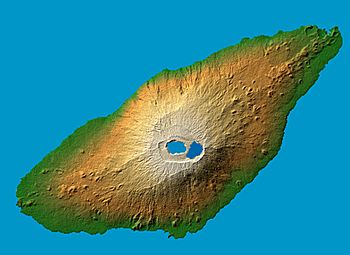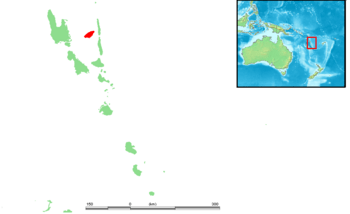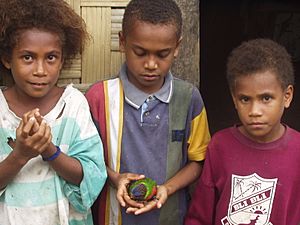Ambae facts for kids
|
Aoba
|
|
|---|---|

False color (elevation) and computed shadow map of Ambae Location within Vanuatu
|
|

Map of Ambae
|
|
| Geography | |
| Location | Pacific Ocean |
| Coordinates | 15°24′0″S 167°50′0″E / 15.40000°S 167.83333°E |
| Archipelago | New Hebrides |
| Area | 398 km2 (154 sq mi) |
| Highest elevation | 1,496 m (4,908 ft) |
| Highest point | Aobahi |
| Administration | |
|
Vanuatu
|
|
| Province | Penama |
| Demographics | |
| Population | 0 (2018) |
| Ethnic groups | Ni-Vanuatu |
| Aobahi | |
|---|---|
| Geography | |
| Location | Vanuatu |
| Topo map | 154 sq mi (400 km2) |
| Geology | |
| Mountain type | Shield volcano |
| Last eruption | June to July 2011 |
Ambae, also known as Aoba, is a beautiful island in the South Pacific nation of Vanuatu. It is located about 165 nautical miles (306 km) north-northwest of Port Vila, Vanuatu's capital city. Ambae is also special because it is Vanuatu's largest active volcano!
Contents
History of Ambae
Europeans first saw Ambae in the spring of 1606. This was during a Spanish trip led by Pedro Fernández de Quirós.
Ambae's misty look from the nearby island of Espiritu Santo inspired a famous story. Espiritu Santo was a big airbase during World War II. The island's mysterious beauty led to the idea of the mythical place called Bali Ha'i. This was in James Michener's book Tales of the South Pacific.
Geography and Nature
Ambae's shoreline and much of its land are made of rough, black volcanic rocks. However, where there is soil, it is very rich. The island looks like it's covered in thick plants and trees. In places where people live, you can see large gardens and managed forests. Closer to the coast, there are usually coconut and cacao plantations.
There are no big rivers or streams on the island. People get their water from special wells or tanks that collect rainwater. Even without rivers, people rarely run out of water.
The weather here is warm and humid all year, like a tropical climate. The average temperature near the coast is about 30°C (86°F). Up on the volcano, it's a bit cooler, around 23°C (73°F). The island gets a lot of rain, from 2500 to 3500 mm (98 to 138 inches) each year. The rainiest time is from November to April.
Important Bird Area
The higher parts of Ambae are very important for birds. BirdLife International has named these areas an Important Bird Area (IBA). This means many special birds live there. These include different kinds of fruit doves, lorikeets, and honeyeaters. You can also find fan-tailed gerygones, trillers, and flycatchers. It's a great place for birdwatching!
The Volcano: Manaro Voui
Ambae Island is actually the top part of Vanuatu's biggest volcano, called Manaro Voui. This volcano rises 1,496 meters (4,908 feet) above sea level. But from the ocean floor, it's about 3,900 meters (12,800 feet) tall!
On November 27, 2005, the volcano started to erupt with steam and ash. This caused a Level 2 volcano alert. People prepared for possible evacuations. By December 8, 2005, the eruption got stronger. More than 3,000 people living on Ambae had to move to other parts of the island. Two hospitals also had to be emptied.
Later, on September 28, 2017, the volcano became very active, reaching Level 4. The government told everyone on the island to leave. About 11,000 people lived there. Ash from the eruption covered the island, harming crops and making the air and water dirty. In April 2018, the remaining 10,000 residents were told to leave permanently.
People of Ambae
Most people on Ambae are Melanesians. Some stories say that ancient Polynesians also mixed with them. This might be why some people on Ambae have lighter skin and speak Polynesian languages.
Almost everyone on Ambae is Christian. There are many different Christian groups. Some are older churches from colonial times, like Anglican and Catholic. Others are newer groups, often from America. There are also many local groups that started in Vanuatu. Missionaries from outside Vanuatu, like the Mormons, are also becoming more popular.
Population and Languages
Ambae has a population of less than 11,000 people. They are divided into three or four main language groups. These include the East Ambae language, West Ambae language, and South Ambae language.
The island does not have any very large towns. However, the main center for the Penama Province is at Saratamata on East Ambae.
Economy and Farming
Most of the local economy on Ambae does not use money. People earn cash by selling crops like copra (dried coconut meat), cacao (for chocolate), and dried kava. This money is mostly used for school fees and small things like soap or salt. Many people also work in public jobs, like teachers. Money sent from family members working in bigger towns also helps the local economy.
Ambae has fewer than 100 telephone lines, mostly on the east side. It has two post offices and two branches of the National Bank of Vanuatu. These are in Saratamata and Nduindui. Ships regularly travel between Ambae and other islands. There are also several Air Vanuatu flights each week. Compared to other smaller islands in Vanuatu, Ambae is quite "developed."
People mostly grow their own food using traditional farming methods. Many villagers also grow a small amount of crops to sell. These crops are often grown in large gardens higher up on the island, where there is good rain and they are safe from pigs. The main foods grown are taro, banana, yam, and manioc. Other foods like sweet potatoes, vegetables, fruits, and nuts provide a good diet. However, sometimes there isn't enough protein. Since Ambae doesn't have many coral reefs, seafood is less common than on other islands. Also, many people live high up inland, away from the coast.
Transportation
Ambae has three airstrips where you can catch flights with Air Vanuatu. These are Walaha Airport in the southwest, Redcliffe Airport in the south, and Longana Airport in the northeast.
Notable People
- Nadia Kanegai - a social entrepreneur and politician.
- Merilyn Tahi - a women's rights activist and co-founder of the Vanuatu Women's Centre.
See also
 In Spanish: Ambae para niños
In Spanish: Ambae para niños


